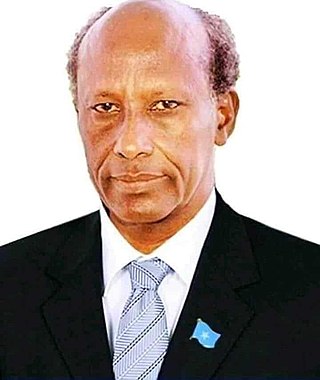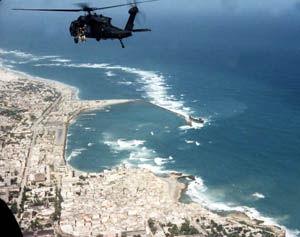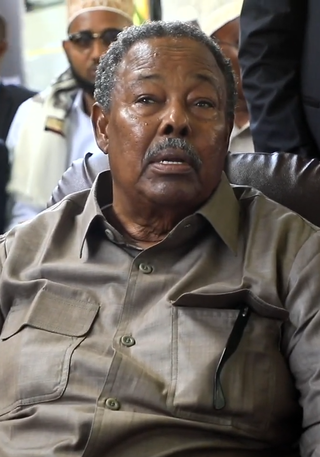
Mohamed Farrah Hassan Garad, known as General Aidid or Aideed, was a Somali general and diplomat.

The Battle of Mogadishu, also known as the Black Hawk Down Incident, was part of Operation Gothic Serpent. It was fought on 3–4 October 1993, in Mogadishu, Somalia, between forces of the United States—supported by UNOSOM II—against the forces of the Somali National Alliance (SNA) and armed irregulars of south Mogadishu.

The United Nations Operation in Somalia II was the second phase of the United Nations intervention in Somalia and took place from March 1993 until March 1995, following the outbreak of the Somali Civil War in 1991. UNOSOM II carried on from the transitory United States-controlled (UN-sanctioned) Unified Task Force (UNITAF), which had been preceded by UNOSOM I. Notably, UNOSOM II embarked on a nation-building mission, diverging from its predecessors. As delineated in UNSCR 814, the operation's objectives were to aid in relief provision and economic rehabilitation, foster political reconciliation, and re-establish political and civil administrations across Somalia.

Ali Mahdi Muhammad was a Somali entrepreneur and politician. He served as President of Somalia from 26 January 1991 to 27 August 1993. The Cairo Agreement in December 1997 designated Ali Mahdi as president once again, a position he held until being succeeded by Abdiqasim Salad in the year 2000.

The Hawiye is the largest Somali clan family. Members of this clan traditionally inhabit central and southern Somalia, Somaliland, Djibouti, Ethiopia and Kenya. They are also the majority in the capital city, Mogadishu.
Hussein Mohamed Farrah Aidid is the son of General Mohamed Farrah Aidid. His father was leader of the Somali National Alliance (SNA), the faction that fought UNOSOM II and US forces during 1993.
The United Somali Congress (USC) was one of the major rebel organizations in Somalia. Formed in 1989, it played a leading role in the ouster of the government of Siad Barre in 1991, and became a target of the Unified Task Force campaign in 1993. Following infighting, the USC later splintered into smaller groups. By 2000, with the establishment of a Transitional National Government (TNG), a process of disarmament was put in motion and some moderate ex-USC leaders were incorporated into the new interim administration.

The Somali Civil War is an ongoing civil war that is taking place in Somalia. It grew out of resistance to the military junta which was led by Siad Barre during the 1980s. From 1988 to 1990, the Somali Armed Forces began engaging in combat against various armed rebel groups, including the Somali Salvation Democratic Front in the northeast, the Somali National Movement in the northwest, and the United Somali Congress in the south. The clan-based armed opposition groups overthrew the Barre government in 1991.

United Nations Operation in Somalia I was the first part of a United Nations (UN) sponsored effort to provide, facilitate, and secure humanitarian relief in Somalia, as well as to monitor the first UN-brokered ceasefire of the Somali Civil War conflict in the early 1990s.

The Transitional National Government (TNG) was the internationally recognized central government of Somalia from 2000 to 2004.
The Somali National Alliance was a major politico-military faction formed on 16 June 1992 by four different rebel groups that had been in opposition to the regime of former Somali President Mohamed Siad Barre. The SNA was the first major inter-clan and inter-factional political alliance and was considered to be among the most powerful factions of the Somali Civil War. The alliance would most notably face off against the second phase of the United Nations Operation in Somalia in the latter half of 1993.

The transitional federal government (TFG) was the government of Somalia between 2004 and 2012. Established 2004 in Djibouti through various international conferences, it was an attempt to restore national institutions to the country after the 1991 collapse of the Siad Barre government and the ensuing Somali Civil War.
The Somali National Front (SNF) was a politico-military organization that operated in southern Somalia during the Somali Civil War and represented one of the major factions involved in the conflict.
Many factions opposed to Siad Barre set aside tribal and political differences to unite in purpose to overthrow his regime. After the collapse of Siad Barre's government in 1991 the nation fell into a long period of increasingly chaotic conflict between forces of clans, militias, warlords, separatist, religious functions and rebellion movements, other nations, and even the United Nations peacekeepers.
Over the course of the Somali Civil War, there have been many revolutionary movements and militia groups run by competing rebel leaders which have held de facto control over vast areas within Somalia.

India–Somalia relations refers to the international relations that exist between India and Somalia.

The Bloody Monday raid, also known as the Abdi House raid or Operation Michigan, was a US military operation that took place in Mogadishu on 12 July 1993, during the United Nations Operation in Somalia II phase of the UN intervention in the Somali Civil War. Carried out by American QRF troops on behalf of UNOSOM II, the raid was the war's deadliest incident in Mogadishu to that point and a turning point in the UN operation. It inflamed anti-UN and anti-American sentiments among Somalis, galvanizing the insurgency that the US military faced during the Battle of Mogadishu three months later.
The June 5th 1993 attack on the Pakistani military was a major confrontation that occurred concurrently in different parts of the Somali capital of Mogadishu, between Somali citizens & militias against the Pakistani peacekeeping contingent of UNOSOM II.

The 1992 famine in Somalia resulted from a severe drought and devastation caused by warring factions in southern Somalia, primarily the Somali National Front, in the fertile inter-riverine breadbasket between the Jubba and Shebelle rivers. The resulting famine primarily affected residents living in the riverine area, predominantly in Bay Region, and those internally displaced by the civil war.














